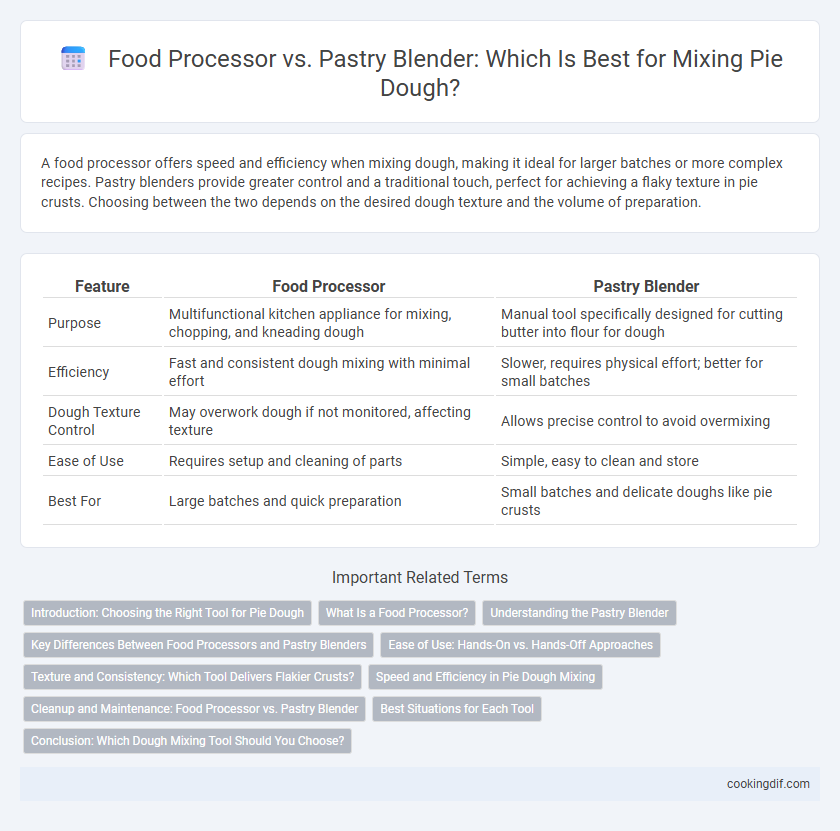A food processor offers speed and efficiency when mixing dough, making it ideal for larger batches or more complex recipes. Pastry blenders provide greater control and a traditional touch, perfect for achieving a flaky texture in pie crusts. Choosing between the two depends on the desired dough texture and the volume of preparation.
Table of Comparison
| Feature | Food Processor | Pastry Blender |
|---|---|---|
| Purpose | Multifunctional kitchen appliance for mixing, chopping, and kneading dough | Manual tool specifically designed for cutting butter into flour for dough |
| Efficiency | Fast and consistent dough mixing with minimal effort | Slower, requires physical effort; better for small batches |
| Dough Texture Control | May overwork dough if not monitored, affecting texture | Allows precise control to avoid overmixing |
| Ease of Use | Requires setup and cleaning of parts | Simple, easy to clean and store |
| Best For | Large batches and quick preparation | Small batches and delicate doughs like pie crusts |
Introduction: Choosing the Right Tool for Pie Dough
A food processor offers speed and efficiency, quickly combining ingredients for a consistent pie dough texture, while a pastry blender provides precise control, allowing for a flaky crust by manually cutting fats into flour. For delicate pie doughs, the pastry blender helps prevent overworking, preserving the desired crumbly structure, whereas the food processor excels in mixing denser doughs evenly. Selecting the appropriate tool depends on the desired crust texture and the amount of dough being prepared.
What Is a Food Processor?
A food processor is an electric kitchen appliance designed to quickly and efficiently mix, chop, and blend ingredients, making it ideal for handling dough with consistent texture and speed. Its powerful motor and sharp blades allow for even incorporation of fats and flours, resulting in a smooth pie crust without overworking the dough. Compared to a manual pastry blender, a food processor significantly reduces preparation time and effort while producing professional-quality pie dough.
Understanding the Pastry Blender
A pastry blender is specifically designed with multiple curved blades or wires to cut cold butter into flour efficiently, essential for creating flaky pie crusts by minimizing gluten development. Food processors can mix dough quickly but risk overworking it, resulting in tougher pastry textures. Understanding the precise function of a pastry blender helps maintain the delicate balance of ingredients, ensuring optimal dough consistency and superior pie crust quality.
Key Differences Between Food Processors and Pastry Blenders
Food processors offer powerful motorized blades that quickly combine ingredients for dough, making them ideal for large batches or complex recipes requiring precise consistency. Pastry blenders feature manual metal blades designed to cut cold butter into flour, preserving a crumbly texture essential for flaky pie crusts. While food processors provide speed and versatility, pastry blenders allow greater control over dough texture, minimizing overmixing and maintaining delicate layers in pastries.
Ease of Use: Hands-On vs. Hands-Off Approaches
A food processor offers a hands-off approach to mixing dough, quickly incorporating ingredients with minimal effort, making it ideal for those seeking convenience and speed. In contrast, a pastry blender provides a hands-on experience, allowing precise control over the dough's texture through manual cutting and blending of fats and flour. For ease of use, food processors excel in reducing physical labor, while pastry blenders are preferred by bakers who value tactile feedback and traditional techniques.
Texture and Consistency: Which Tool Delivers Flakier Crusts?
A food processor rapidly combines ingredients, producing a uniformly mixed dough that can result in a more tender crust but may risk overworking gluten, leading to less flakiness. A pastry blender manually cuts cold butter into flour, preserving distinct fat pockets that create the ideal flaky layers in pie crusts. For a flaky pie crust, the controlled texture and consistency achieved with a pastry blender typically deliver superior flakiness compared to the food processor's more homogenized dough.
Speed and Efficiency in Pie Dough Mixing
A food processor significantly reduces mixing time by quickly combining ingredients for pie dough with minimal effort, ensuring consistent texture and optimal gluten development. In contrast, a pastry blender requires more manual labor and time, often leading to uneven mixing and slower dough preparation. For speed and efficiency in pie dough mixing, a food processor is the superior tool, especially for frequent bakers seeking uniform results.
Cleanup and Maintenance: Food Processor vs. Pastry Blender
Food processors offer quick and efficient dough mixing but require thorough disassembly and careful cleaning of multiple parts to avoid dough residue buildup. Pastry blenders consist of a simple handle and blades, making cleanup easier and faster with minimal maintenance. Regular blade sharpening and washing by hand keep pastry blenders functional, while food processors need periodic motor care and dishwasher-safe parts for optimal performance.
Best Situations for Each Tool
A food processor excels at quickly combining ingredients for pie dough, especially when making large batches or flaky crusts, as its sharp blades efficiently cut cold butter into flour. A pastry blender is ideal for small quantities or delicate recipes where more control over texture is needed, allowing gradual blending to avoid overworking the dough. Use a food processor for speed and consistency, and a pastry blender for precision and traditional technique.
Conclusion: Which Dough Mixing Tool Should You Choose?
Choose a food processor for speed and efficiency when mixing dough, especially for large batches or recipes requiring uniform texture. Opt for a pastry blender if you prefer manual control, better texture retention, and traditional techniques in smaller dough preparations. Both tools excel in different scenarios, but food processors offer versatility beyond dough mixing, making them a worthwhile investment for multitasking in the kitchen.
Food processor vs Pastry blender for mixing dough Infographic

 cookingdif.com
cookingdif.com